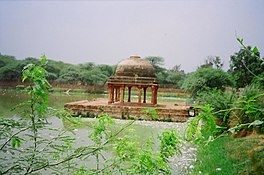| Hauz-i-Shamsi | |
|---|---|
 View of the pavilion in Hauz-i-Shamsi | |
| Coordinates | 28°30′51″N 77°10′42″E / 28.51417°N 77.17833°E |
| Type | Reservoir |
| Basin countries | India |
| Surface area | 2 ha (5 acres) |
| Settlements | Mehrauli |
Hauz-i-Shamsi (literally "sunny water tank"), also known as Shamsi Talab, is a water reservoir built by Iltutmish of the Slave Dynasty in 1230 CE. According to legend, its location was revealed to him in a dream by the Islamic prophet Muhammad. A palace known as the Jahaz Mahal was constructed on the eastern edge of the same reservoir during the Lodi dynasty in the 16th century, serving as a retreat or inn for pilgrims. At the edge of Hauz-i-Shamsi stands the tomb of Abdul-Haqq Dehlavi, a 17th-century Persian writer at the Mughal court. The monuments are situated in the sprawling environs of Mehrauli, Delhi.[1][2][3][4][5]
- ^ "Hauz-i-Shamsi(Hauz)". Pilgrimage Tours. Retrieved 21 June 2009.
- ^ Lucy Peck (2005). Delhi - A thousand years of Building. New Delhi: Roli Books Pvt Ltd. p. 233. ISBN 81-7436-354-8. Retrieved 21 June 2009.
This great tank, built by Iltumish, was originally much larger. The pavilion, now attached to the west bank, was formerly in the middle of the tank; it is supposed to cover the foot print of a horse, ridden by the Muhammad, who told Iltumish in a dream where to build the tank.
{{cite book}}:|work=ignored (help) - ^ Y.D.Sharma (2001). Delhi and its Neighbourhood. New Delhi: Archaeological Survey of India. pp. 63–64 & 73. Retrieved 24 April 2009.
{{cite book}}:|work=ignored (help)[permanent dead link] - ^ Patrick Horton; Richard Plunkett; Hugh Finlay (2002). Delhi. Footscray, Vic.: Lonely Planet. p. 128. ISBN 978-1-86450-297-8.
{{cite book}}:|work=ignored (help) - ^ "The Tomb of Shaikh 'Abdul Haq Dihlavi". British Library. 1843. Archived from the original on 12 August 2017. Retrieved 28 July 2009.
